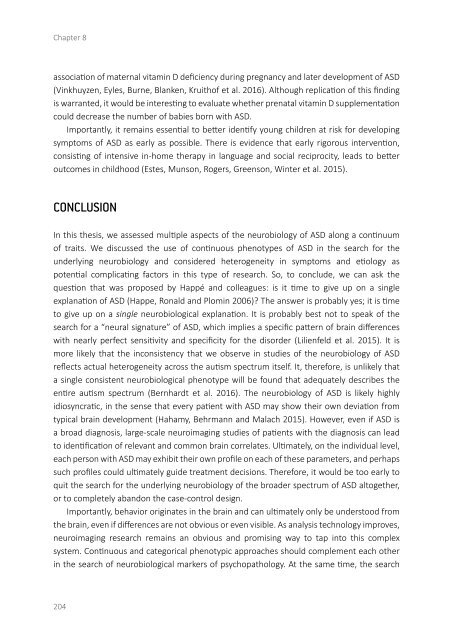On the Spectrum
2lm5UyR
2lm5UyR
Create successful ePaper yourself
Turn your PDF publications into a flip-book with our unique Google optimized e-Paper software.
Chapter 8<br />
association of maternal vitamin D deficiency during pregnancy and later development of ASD<br />
(Vinkhuyzen, Eyles, Burne, Blanken, Kruithof et al. 2016). Although replication of this finding<br />
is warranted, it would be interesting to evaluate whe<strong>the</strong>r prenatal vitamin D supplementation<br />
could decrease <strong>the</strong> number of babies born with ASD.<br />
Importantly, it remains essential to better identify young children at risk for developing<br />
symptoms of ASD as early as possible. There is evidence that early rigorous intervention,<br />
consisting of intensive in-home <strong>the</strong>rapy in language and social reciprocity, leads to better<br />
outcomes in childhood (Estes, Munson, Rogers, Greenson, Winter et al. 2015).<br />
CONCLUSION<br />
In this <strong>the</strong>sis, we assessed multiple aspects of <strong>the</strong> neurobiology of ASD along a continuum<br />
of traits. We discussed <strong>the</strong> use of continuous phenotypes of ASD in <strong>the</strong> search for <strong>the</strong><br />
underlying neurobiology and considered heterogeneity in symptoms and etiology as<br />
potential complicating factors in this type of research. So, to conclude, we can ask <strong>the</strong><br />
question that was proposed by Happé and colleagues: is it time to give up on a single<br />
explanation of ASD (Happe, Ronald and Plomin 2006)? The answer is probably yes; it is time<br />
to give up on a single neurobiological explanation. It is probably best not to speak of <strong>the</strong><br />
search for a “neural signature” of ASD, which implies a specific pattern of brain differences<br />
with nearly perfect sensitivity and specificity for <strong>the</strong> disorder (Lilienfeld et al. 2015). It is<br />
more likely that <strong>the</strong> inconsistency that we observe in studies of <strong>the</strong> neurobiology of ASD<br />
reflects actual heterogeneity across <strong>the</strong> autism spectrum itself. It, <strong>the</strong>refore, is unlikely that<br />
a single consistent neurobiological phenotype will be found that adequately describes <strong>the</strong><br />
entire autism spectrum (Bernhardt et al. 2016). The neurobiology of ASD is likely highly<br />
idiosyncratic, in <strong>the</strong> sense that every patient with ASD may show <strong>the</strong>ir own deviation from<br />
typical brain development (Hahamy, Behrmann and Malach 2015). However, even if ASD is<br />
a broad diagnosis, large-scale neuroimaging studies of patients with <strong>the</strong> diagnosis can lead<br />
to identification of relevant and common brain correlates. Ultimately, on <strong>the</strong> individual level,<br />
each person with ASD may exhibit <strong>the</strong>ir own profile on each of <strong>the</strong>se parameters, and perhaps<br />
such profiles could ultimately guide treatment decisions. Therefore, it would be too early to<br />
quit <strong>the</strong> search for <strong>the</strong> underlying neurobiology of <strong>the</strong> broader spectrum of ASD altoge<strong>the</strong>r,<br />
or to completely abandon <strong>the</strong> case-control design.<br />
Importantly, behavior originates in <strong>the</strong> brain and can ultimately only be understood from<br />
<strong>the</strong> brain, even if differences are not obvious or even visible. As analysis technology improves,<br />
neuroimaging research remains an obvious and promising way to tap into this complex<br />
system. Continuous and categorical phenotypic approaches should complement each o<strong>the</strong>r<br />
in <strong>the</strong> search of neurobiological markers of psychopathology. At <strong>the</strong> same time, <strong>the</strong> search<br />
204


